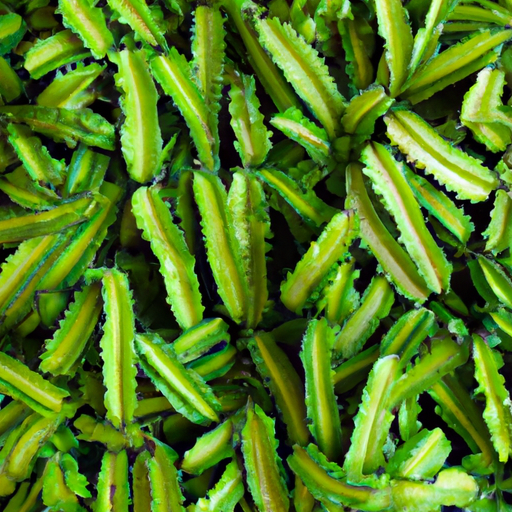Winged Beans: A Unique and Nutritious Delight
If you’re a food enthusiast always on the lookout for exciting, lesser-known ingredients, let me introduce you to the intriguing world of winged beans. Also known as “Manila beans” or “sigarilyas,” these little green wonders are making their way into kitchens and dining tables around the globe. With their vibrant appearance, remarkable flavor profile, and impressive nutritional value, winged beans have a lot to offer in the culinary world.
A Visual Delight
One glance at a winged bean and you’ll immediately understand how it gets its name. These legumes boast long, slender pods with distinctive ridges often referred to as “wings.” As you start exploring their many culinary possibilities, you’ll be struck by their vibrant green color and unique shape. Winged beans add an undeniable visual appeal to any dish, making them a favorite among creative cooks and passionate food photographers.
Taste and Texture
But it’s not just their appearance; winged beans bring an exciting array of flavors and textures to the table. The taste is often described as nutty, reminiscent of a combination of green beans and asparagus. When cooked, the texture becomes wonderfully crisp and tender, making them a delightful addition to stir-fries, salads, and soups. Their mild flavor profile pairs well with a vast array of ingredients, allowing them to shine in both simple and complex dishes.
Versatility in the Kitchen
Winged beans are highly versatile, offering endless possibilities for culinary experimentation. Commonly used in Southeast Asian cuisines, particularly in Indonesia, Malaysia, and the Philippines, they can be found in a wide range of dishes. Whether you’re looking to incorporate them into a comforting curry, a vibrant vegetable stir-fry, or a refreshing summer salad, winged beans will elevate your recipes with their unique taste and texture.
One popular Southeast Asian dish featuring winged beans is “Ginataang Sigarilyas,” which translates to “winged beans cooked in coconut milk.” In this creamy and fragrant preparation, the beans are gently simmered in a rich coconut broth with spices and sometimes combined with shrimp or chicken. The result is a sublime combination of flavors that perfectly showcases the versatility of winged beans in traditional cooking.
Nutritional Powerhouse
Aside from their culinary attributes, winged beans are also packed with essential nutrients. They are a fantastic source of plant-based protein, making them an excellent option for vegetarians and vegans. Additionally, they are rich in dietary fiber, which aids digestion and helps maintain a healthy gut.
Winged beans also offer an array of vitamins and minerals, including vitamin C, vitamin A, potassium, and iron. These antioxidants and minerals contribute to their reputation as a nutritious powerhouse. So not only do they add a delightful touch to your meals, but they also contribute to your overall well-being.
Interesting Facts and History
Delving into the fascinating history of winged beans, we find that they have been a staple in Southeast Asian cuisines for centuries. Native to Papua New Guinea, they have been cultivated in the region since ancient times. Winged beans spread across Asia, reaching Indonesia, Malaysia, and the Philippines, where they eventually became integral to the local culinary traditions.
It’s worth noting that winged beans are not limited to Southeast Asia alone. They have also found their way into various dishes in other parts of the world, including Africa, South America, and the Caribbean. This global appreciation for winged beans further highlights their versatility and adaptability to different cooking styles and flavors.
Try Winged Beans Today!
With their alluring appearance, delightful taste, and nutritional benefits, winged beans deserve a spot on your culinary radar. Whether you’re a seasoned cook or a kitchen novice, these unique legumes offer countless opportunities for experimentation and creativity. So, next time you’re exploring your local farmers’ market or international grocery store, keep an eye out for these distinctive green pods and bring an exciting new ingredient into your kitchen. Happy cooking with winged beans!
Winged Beans
Origin: Winged beans, also known as Goa beans, are native to New Guinea and parts of Southeast Asia, including Indonesia, Malaysia, and the Philippines. They have been cultivated in these regions for centuries.
Common Uses: Winged beans are versatile and are used in various culinary preparations. The immature pods, leaves, flowers, and tubers are all edible. The pods can be cooked and eaten like green beans, added to stir-fries or curries, or used in soups and stews. The leaves are often used as leafy greens in salads or cooked dishes. The flowers can be eaten raw or used as a garnish, and the tubers can be boiled or roasted and used as a vegetable. The entire plant is edible and offers different flavors and textures depending on the part used.
Nutritional Benefits: Winged beans are a nutrient-rich ingredient. They are a good source of protein and dietary fiber, making them beneficial for vegetarian or vegan diets. They also contain essential vitamins and minerals such as vitamin C, vitamin A, calcium, iron, and phosphorus.
Unique Properties: One distinctive feature of winged beans is their wing-like projections that run along the edges of their pods. These wings give the beans their name and provide a unique appearance. Additionally, the plant is a nitrogen-fixing legume, which means it can enrich the soil by converting atmospheric nitrogen into a form that can be used by plants.
Historical Significance: Winged beans have a long history of cultivation and consumption in Southeast Asia. They have been a traditional crop in this region for centuries and play a significant role in the local cuisines and diets. In some cultures, the entire plant is highly valued for its versatility, nutrition, and sustainability as a food source.




Use the share button below if you liked it.
It makes me smile, when I see it.